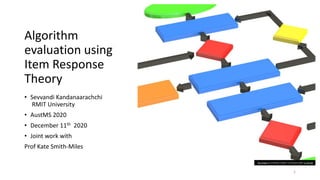
Algorithm Portfolio Evaluation using Item Response Theory
- 1. Algorithm evaluation using Item Response Theory • Sevvandi Kandanaarachchi RMIT University • AustMS 2020 • December 11th 2020 • Joint work with Prof Kate Smith-Miles 1 This Photo by Unknown Author is licensed under CC BY-ND
- 2. Overview Algorithm portfolio evaluation Introduction to Item Response Theory (IRT) Mapping IRT to algorithm evaluation New metrics and reinterpretation Anomaly detection algo. portfolio Diagnostics
- 3. Algorithm Portfolio Evaluation • Results from many algorithms on many problems • How do we evaluate the portfolio of algorithms? • Statistical methods: Friedman test, post- hoc tests -> Ranking of algorithms • On average Ranking • Individual characteristics buried under average performance 3
- 4. Item Response Theory • Latent trait models used in social sciences/psychometrics • Unobservable characteristics and observed outcomes • Verbal or mathematical ability • Racial prejudice or stress proneness • Political inclinations • Intrinsic “quality” that cannot be measured directly This Photo by Unknown Author is licensed under CC BY-SA
- 5. IRT in education • 𝑁 Students (participants) answer 𝑛 questions (test item) • Student ability (latent trait continuum) • Test item discrimination • Test item difficulty This Photo by Unknown Author is licensed under CC BY 5
- 6. Dichotomous IRT • Multiple choice • True or false • 𝜙 𝑥𝑖𝑗 = 1 𝜃𝑖, 𝛼𝑗, 𝑑𝑗, 𝛾𝑗 = 𝛾𝑗 + 1 −𝛾 𝑗 1+exp(−𝛼 𝑗(𝜃 𝑖−𝑑 𝑗)) • 𝑥𝑖𝑗 - outcome/score of examinee 𝑖 for item 𝑗 • 𝜃𝑖 - examinee’s (𝑖) ability • 𝛾𝑗 - guessing parameter for item 𝑗 • 𝑑𝑗 - difficulty parameter • 𝛼𝑗 - discrimination This Photo by Unknown Author is licensed under CC BY-NC 6
- 7. Polytomous IRT • Letter grades • Score out of 5 • Theta is the ability • For each score there is a curve • 𝑃(𝑥𝑖𝑗 = 𝑘|𝜃𝑖, 𝑑𝑗, 𝛼𝑗) • For a given ability what's the score you’re most likely to get 7
- 8. Continuous IRT • Grades out of 100 • A 2D surface of probabilities • 𝑃(𝑧𝑖𝑗|𝜃𝑖, 𝑑𝑗, 𝛼𝑗) 8
- 9. Mapping algorithm evaluation to IRT • Item characteristics • Difficulty, discrimination • Person characteristic • Ability • In traditional IRT • examinees > > questions IRT Model Person-doing something Test - inanimate 9
- 10. Mapping IRT to algorithm evaluation (Standard) • Dataset (item) characteristics • Difficulty, discrimination • Algorithm (person) characteristic • Ability • We are evaluating datasets more than algorithms! IRT Model Algorithm-doing something Dataset - inanimate 10
- 11. New Inverted Mapping • Dataset (person) characteristic • Person ability dataset easiness • Algorithm (item) characteristics • Item difficulty algo. easiness threshold • Item discrimination algo stability, and anomalousness • Now we are evaluating algorithms more than datasets. IRT Model Algorithm-doing something Dataset - inanimate 11
- 12. What are these new parameters? • IRT - 𝜃𝑖 - ability of examinee 𝑖 • 𝜃 increases probability of a higher score increases • What is 𝜃𝑖, in terms of a dataset? • 𝜃𝑖 - easiness of the dataset 12
- 13. What are these new parameters? • IRT - 𝛼𝑗- discrimination of item 𝑗 • 𝛼𝑗increases → slope of curve increases • What is 𝛼𝑗, in terms of an algorithm? • 𝛼𝑗- lack of stability/robustness of algo • (1/|𝛼 𝑗|)- stability/robustness of algo 13
- 14. Stable algorithms • Education – such a question doesn’t give any information • Algorithms – these algorithms are really stable • Stability = 1/|𝛼𝑗| 14
- 15. Anomalous algorithms • Algorithms that perform poorly on easy datasets and well on difficult datasets • Negative discrimination • In education – such items are discarded or revised • If an algorithm anomalous, it is interesting • Anomalousness = sign(𝛼𝑗) This Photo by Unknown Author is licensed under CC BY-NC-ND 15
- 16. Fitting Continuous IRT models • Continuous models • Does not fit items (algorithms) with negative discrimination • d • 𝛼𝑗 - discrimination parameter, 𝛾𝑗 - scaling parameter (for this formulation). . . Assumption 𝛼𝑗 > 0, 𝛾𝑗 > 0 • 𝐶𝑗 - Covariance term • 𝑡 - the iteration • Negative covariance stops convergence 16 Minimize this Variance term
- 17. Fitting continuous IRT models 17 • Probability of score, given the ability • Works if both 𝛼𝑗 > 0, 𝛾𝑗 > 0 OR 𝛼𝑗 < 0 , 𝛾𝑗 < 0 → 𝑠𝑖𝑔𝑛 𝛼𝑗 = 𝑠𝑖𝑔𝑛 𝛾𝑗 • So modify the original assumption 𝛼𝑗 > 0, 𝛾𝑗 > 0 to 𝑠𝑖𝑔𝑛 𝛼𝑗 = 𝑠𝑖𝑔𝑛 𝛾𝑗
- 18. Anomaly detection (8 algos, 3142 datasets) 18
- 19. What about the latent trait? (dataset easiness spectrum) 19
- 21. Dataset easiness and algorithm performance 21
- 22. Dataset easiness and algorithm performance 22 Latent trait occupancy! How much latent trait do you occupy?
- 23. Diagnostics 23
- 24. How well does the IRT model fit? • Difference 𝑦𝑖𝑗 = |𝑥𝑖𝑗 − ො𝑥𝑖𝑗| • Cumulative distribution of these differences • 𝑃(𝑦𝑖𝑗 ≤ 𝑐) for different 𝑐 • Model goodness curve (MGC) • Area under this curve (AUMGC) • Higher AUMGC is better • Same idea for polytomous and continuous 24
- 25. Effectiveness of algorithms • Effective algorithms give better performances for most datasets • 𝑃 𝑥𝑖𝑗 ≥ 𝑐 - Actual • 𝑃 ො𝑥𝑖𝑗 ≥ 𝑐 - Predicted • Area under these curves • Area Under Actual Effectiveness Curve (AUAEC) • Area Under Predicted Effectiveness Curve (AUPEC) 25
- 26. Actual and Predicted effectiveness • We can plot (AUAEC, AUPEC) as well. 26
- 27. Summary • Evaluating a portfolio of algorithms • Use Item Response Theory from Psychometrics • Accommodating it to include negative discrimination • Inverting the intuitive mapping -> elegant reinterpretation • A richer understanding of algorithms • Includes additional diagnostics to test the goodness of the IRT model • R package airt (on CRAN) • https://sevvandi.github.io/airt/ • Pre-print: http://bit.ly/algorithmirt • Comprehensive Algorithm Portfolio Evaluation using Item Response Theory • More applications included 27
- 28. 28
